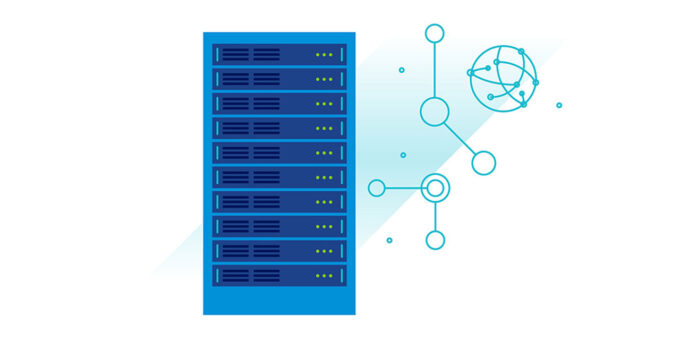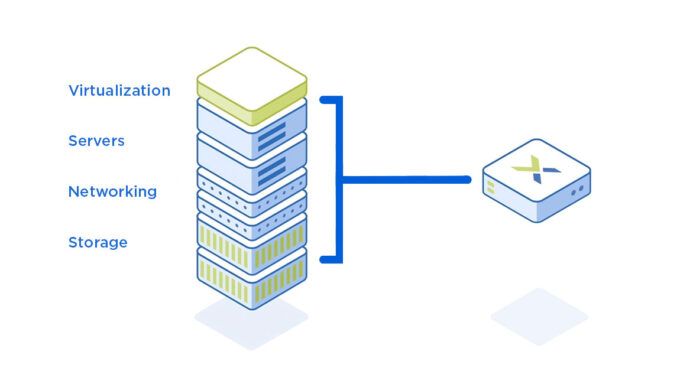As hybrid infrastructures raise IT complexity, contemporary businesses want infrastructures that promote scalability, performance, and simplicity more than ever. Hyperconverged infrastructure is a popular choice among many business professionals. Hyperconverged infrastructure (HCI) is a distributed infrastructure system that combines storage and servers with intelligent software to produce customizable building blocks that replace historical infrastructure that consists of storage arrays, storage networks, and individual servers.
It mixes commodity data center server hardware with locally connected storage devices, and a distributed software layer drives it to remove typical pain points associated with outdated infrastructure. Let us look at how hyperconverged infrastructure changes companies in this piece. But first, let us discuss how HCI works.

How Does Hyperconverged Infrastructure Work?
HCI combines the complete data center stack, such as virtualization, networking, storage, and computing. Costly and complex legacy infrastructure is replaced with a distributed platform operating on industry-standard commodity servers, allowing organizations to scale and precisely size workloads as required. Every server, also called a node, is equipped with x86 CPUs, HDDs, and SSDs. For greater speed and robustness, software running on every node distributes all operational functions throughout the cluster.
Moreover, hardware platform options are available to meet any demand by scaling the different resources individually and may be provided with or without a GPU for graphics enhancement. To enhance storage performance, all nodes have flash, and all-flash nodes are offered to enable optimum I/O throughput with minimal latency for all business purposes.
HCI solutions consist of a management pane with the compute platform and distributed storage, allowing you to administer HCI resources from a single interface. This removes the requirement for virtualization management systems, storage networks, storage, and separate servers.
How Does Hyperconverged Infrastructure Transform Businesses?

While HCI is unique in its architecture, the ultimate test of its worth is in the practical advantages it delivers to data center administration and operations. Here are ten ways in which HCI might assist the organization:
Hardware Consolidation
While the overarching myth about hyperconverged infrastructure is that it allows for more scalability, the true advantage is that it allows for very dense infrastructure footprints. This will assist the organization in moving away from today’s ad hoc data centers and toward sleeker, more compact systems that provide high-performance levels in highly constrained locations.
Increased Resource Efficiency
HCI and associated cloud resources enable enterprises to create resources accessible to a larger number of users both within and outside the corporation. HCI, which uses integrated fabric technologies and high-speed storage, can distribute and pool resources more dynamically than older infrastructure.
Business Outcomes or Service-Level Objectives
HCI enables enterprises to simplify customer service delivery while driving application and product development efficiency. This, in turn, increases the potential to cater to particular user demands and target specialized markets.
Platform Integration

Since HCI will probably be based on commodity hardware, organizations will have better capacity than in the past to combine several virtual architectures and data platforms. These systems may only sometimes function flawlessly together, but they will no longer need their hardware to deliver good service. As a greenfield implementation, HCI is far more suited to software-defined data center (SDDC) structures than older hardware. In reality, most HCI installations have been designed with highly abstract data environments in mind.
Composable Infrastructure
By using HCI as the foundation for fully virtualized infrastructure, companies may manage that infrastructure as services that can be mixed and matched instead of systems that are inextricably bound to hardware. As additional HCI modules are added to the environment, they may join the unified pool of resources without the time-consuming, complex integration and provisioning chores that plague the present infrastructure.
Hybrid or Private Clouds
Organizations quickly realize that cloud computing is incompatible with outdated applications or infrastructure. HCI is the fastest and most straightforward approach to deploying an optimized, scalable hardware layer for the rising army of cloud-native microservices and applications.
Artificial Intelligence

This dynamic also holds for AI technologies such as voice recognition, neural networks, and machine learning. These technologies require vast computational capabilities, which are prohibitively costly to implement conventionally but manageable with hyperconverged infrastructure.
Automation
Even intelligent automation struggles to navigate disparate groupings of software and hardware. HCI values consistency, which makes it simpler to automate processes that execute similar tasks in the same manner.
Cost Management
The desire to reach a bigger scale and better performance levels without entirely blowing the IT-allocated expenses out of the water is at the core of these changes. HCI outperforms conventional infrastructure regarding time spent, computing cycle, Gbps, price per GB, set-up and administration.
What Advantages Can Hyperconverged Infrastructure Provide?

By offering a single unified software layer over a whole IT ecosystem, hyperconvergence removes silos systems. This seamless integration benefits Organizations with reliability, agility, and improved system performance. Hyperconvergence also has the following advantages:
- Efficient scalability: HCI provides remarkable adaptability, allowing enterprises to increase and reduce workloads as requirements change.
- Decreased complexity and administrative load: Legacy infrastructure is often a jumble of systems installed piecemeal over time, complicating maintenance, and administration. It maintains and manages a single unified system that spans many environments via HCI.
- Affordability: HCI is inexpensive since it employs commodity hardware. Its use of virtual machines (VMs) also enables enterprises to utilize less hardware overall, saving money on cooling and power.
- Simplified management: Administration is simplified because HCI makes administration incredibly straightforward and efficient, and it does not need highly specialized expertise, as specific purpose-built legacy systems do.
HCI lets businesses utilize their networking resources, storage, and computing more thoroughly and effectively by optimizing resource and infrastructure use.
Is Hyperconvergence Good for Your Company?
There are several aspects to take into account. If cost savings and simplicity are your top concerns, HCI may be your best choice since it may drastically decrease your IT footprint while reducing opex and capex when implemented appropriately. Furthermore, hyperconverged is no longer a novel concept; it’s a fundamental component of a complex and growing IT ecosystem. In addition, HCI solutions are intended to handle various workloads and might not be optimal for specific use cases.









